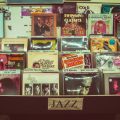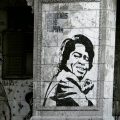Are you a fan of blues music that has just got their very own record player? Are you the owner of a record player that is looking to branch out their music tastes and put the warm tonal capabilities of a record player and stereo system to good use by using it as a conduit for the blues?
Then you are in the right place, for today we will be going through some of my personal favorite best blues albums that I think sound even better on vinyl.

Table of Contents
- 1. Small Change – Tom Waits
- 2. Moanin’ in the Moonlight – Howlin’ Wolf
- 3. Safe as Milk by Captain Beefheart and His Magic Band
- 4. Taj Mahal – Taj Mahal
- 5. Father of Folk Blues – Son House
- 6. The Complete Recordings – Robert Johnson
- 7. Folk Singer – Muddy Waters
- 8. Gospel Train – Sister Rosetta Tharpe
- 9. The Source – Ali Farka Touré
- 10. A Meeting by the River – Ry Cooder & Vishwa Mohan Bhatt
- 11 Blues – Jimi Hendrix
- Final Tones
1. Small Change – Tom Waits
Beginning this collection of blues music, we have an offering from American popular culture legend Tom Waits who, though more heavily influenced by jazz vinyls, has much in common with electric blues and Chicago blues music.
In fact, now might be a good time to get to know the amount of crossover there is between jazz and blues music. Artists like John Lee Hooker are frequently placed in a binary box as opposed to other jazz artists when, really, jazz came from blues music, developing a slightly more complex harmonic sense over time as audiences came to expect more.
Contrasted with an artist like Eric Clapton, Waits was willing to get down with those who invented the blues. The first track, for example, is allegedly about a Danish singer he met while on tour: ‘Uh, well I met this girl named Matilda. And uh, I had a little too much to drink that night. This is about throwing up in a foreign country.’
Related Read: Top 100 Most Valuable Vinyl Records
The producer of the album Bones Howe goes on to describe the actual writing of the song:
‘He said the most wonderful thing about writing that song. He went down and hung around on skid row in L.A. because he wanted to get stimulated to write this material. He called me up and said, “I went down to skid row … I bought a pint of rye. In a brown paper bag.” I said, “Oh really?” “Yeah – hunkered down, drank the pint of rye, went home, threw up, and wrote ‘Tom Traubert’s Blues’ […] Every guy down there … everyone I spoke to, a woman put him there.” ‘
2. Moanin’ in the Moonlight – Howlin’ Wolf
A significant vocal inspiration for Tom Waits comes in the form of a certain Howlin’ Wolf, a now infamous performer known for his beyond potent vocal abilities. Though this style was certainly related to the electric blues, this is a far cry from later advancers of the music like Stevie Ray Vaughan and his blues band, who were more known for their fusion of blues rock.
This album is actually a compilation album. The album format was not entirely commonplace until the 60s or so unless as a collation of a number of separate singles when record players were popular. The songs contained herein are no less potent for having been recorded and released on separate occasions, though. Many are exemplars of the blues song and of blues guitar in general.
There were several pressing plants on the case, in fact, so this record might well make several appearances on a list of the top 100 most valuable vinyl records.
This is clearly one of the more influential blues albums as well as one of the most legendary modern recordings of the 20th century. Musician and musicologist Robert Palmer even cited the song ‘How Many More Years’ as featuring the first distorted power chord on a recording, courtesy of the legendary guitarist Willie Johnson who supported Howlin’ Wolf for several years.
Surely one of the greatest blues albums even despite only being a compilation of singles, these are some of Howlin’ Wolf’s best songs collated all in one place.
3. Safe as Milk by Captain Beefheart and His Magic Band
Once you hear Howlin’ Wolf in any of his guises, it is impossible not to hear him steeped all over Captain Beefheart’s own vocals.
There is no end of moments where the vocals drift from his psychedelic croon right into the pocket of those delta Blues singers that he and Frank Zappa would have listened to so much when growing up. And this continues throughout his whole career.
Nowhere is the influence of the blues more readily prevalent in Beefheart’s music than on his debut record Safe as Milk. The vocals are all there, drums skitter between psychedelia and country blues, and the guitars reek of the good stuff – like Chicago bluesman Jimmy Rogers – courtesy of an adolescent Ry Cooder. All told, an exemplary study of how vinyl records are made.
The influence of the delta blues is evident from the very first line of the first song ‘Sure ‘Nuff ‘n Yes I Do’, which quotes ‘New Minglewood Blues’ by the Cannon’s Jug Stompers, itself an early version of Muddy Waters’ ‘Rollin’ and Tumblin’ ‘.
There was a great deal more surrealism in Beefheart’s lyrics, though, as if he had been steeped in the veritable swamps of the Mississippi Delta:
‘Mother say son, she say son, you can’t lose, with the stuff you use
Abba Zabba go-zoom Babbette baboon
Run, run, monsoon, Indian dream, tiger moon.’
Surrealism and psychedelia that is mirrored in the use of unconventional blues instrumentation like the theremin and the marimba.
4. Taj Mahal – Taj Mahal
Before joining the Magic Band, Ry Cooder was a member of a band featuring the legendary New York blues musician Taj Mahal, an exemplary recording artist in his own right who has sought to fuse the blues with a whole variety of other genres throughout the world, enlisting sounds from the Caribbean, Africa, India, Hawaii, and the South Pacific.
His explorative musical style is a far cry from artists like Robert Johnson and Buddy Guy, though he was admittedly working in a very different era and it is upon the shoulders of those latter two giants that many of these artists stand.
In this way, he is considered ‘one of the first major artists, if not the very first one, to pursue the possibilities of world music’ with ‘even the blues he played in the early 70s’ showing ‘an aptitude for spicing the mix with flavors that always kept him a yard or so distant from being an out-and-out blues performer.’
In this way, Taj Mahal can be considered a little more like Jimi Hendrix in terms of his experimental and playful spirit in fusing together different genres of music. If Hendrix became interested in more acoustic and folk-inspired forms of music, then I do not doubt that it would at least resemble something of Taj Mahal’s experiments in this field.
Here, we see him closest to traditional blues, though it would not be long before his ethnomusicology drew him toward other styles of music from around the world and the incorporation of them into his colorful and varied tonal palette.
5. Father of Folk Blues – Son House
In his formative years, Taj Mahal was inspired by Son House, just as he was inspired by other greats like Jimmy Reed, Sleepy John Estes, and Sonny Terry.
Son House did actually what it says on the tin, offering forth an intimate and dear experience of blues music that is equal parts folk too. His emotionally charged vocal delivery and esteemed slide guitar playing are inimitable.
Related Read: Best Jazz Vinyl Albums
Ironic seeing as he was hostile to secular music for a number of years. It is not hard to see where the emotional charge comes from in his music when we come to know that he was a preacher and church pastor for a number of years before coming to a blues performance at the age of 25.
After acquiring a bit of a name for himself in the Delta and recording with the foremost musician of the region Charley Patton, he gave up music, though not before laying influence upon a young Robert Johnson and Muddy Waters.
In the mid-60s, he was encouraged by some record collectors to relearn his songs and return as an entertainer. It is from this period that the album above comes from when he was billed as a folk blues singer for concert tours during the American folk music revival.
Not bad for a country boy who did not, at one point, even believe in such forms of secular music.
6. The Complete Recordings – Robert Johnson
A list of this kind seems remiss to not include the hallowed king of the Delta blues, Robert Johnson himself.
As a young man living in rural Mississippi, Johnson had a great desire to become a famous blues musician and so, upon direction, he went to a crossroad near a local plantation at midnight with his guitar.
Here is a great list of the best blues songs on acoustic guitar.
There he was supposedly met by the devil who took the guitar and tuned it, then played a few songs upon it before returning it to Johnson and bestowing upon him his relative guitar mastery. Thus, in exchange for his soul, he was given mastery over his blues, for which he eventually became famous.
Regardless of the apocryphal nature of the tale, Johnson’s influence on the landscape of blues and subsequently on rock and roll is not up for debate.
Considering his widespread influence on Western music, it seems boggling to think that this man was part of only two record sessions in his whole life: one in San Antonio in 1936, and the other in Dallas in 1937, producing 29 separate songs in that time.
And these recordings remain one of the only artifacts left of the man himself, whose existence was known very little outside of the musical circuits established for this kind of music within the Mississippi Delta, so it is no surprise that his life has given rise to so much legend.
7. Folk Singer – Muddy Waters
Muddy Waters, though of course incredibly accomplished in his own right, was likewise inspired by the contemporaneous blues peregrinations of Son House and Robert Johnson.
Like Son House, he was recorded by ethnomusicologist Alan Lomax in a landmark series of field recordings for the Library of Congress. Unlike Son House, however, he continued his career after these fateful recordings instead of hanging up his guitar.
He moved to Chicago itself to become a musician full time, recording his first records for Columbia and then for Aristocrat Records. Through a number of years performing in the West, he even sowed the seeds for the eventual revival of interest in the blues in England, doing so in 1958 prior to the burgeoning of blues-based rock and roll.
His influence on 60s rock and roll is undisputed. Jimi Hendrix had strong memories of hearing him ‘as a little boy and it scared me to death’. Several bands, like Cream, have covered his song ‘Rollin’ and Tumblin”, despite Clapton being a massive figurehead for white fragility.
Related Read: Best Funk Albums
Led Zeppelin ‘borrowed’ some of the lyrics from Waters’ hit ‘You Need Love’ on ‘Whole Lotta Love’, continuing the already established trend of stealing the music of black people and using it for oneself.
Fellow artist B.B. King, upon Waters’ death, spoke a fitting obituary to his influence: ‘It’s going to be years and years before most people realize how greatly he contributed to American music.’
8. Gospel Train – Sister Rosetta Tharpe
Yes, you did read correctly, this album is indeed called Gospel Train, though the relative conflagration of the melting pot between gospel and blues is real and scarcely rings more true than on this album.
Tharpe was one of the first stars of recorded gospel music, though is equally revered by progenitors of rock and roll as being highly influential, particularly in the harsh and distorted guitar tone that she was fond of using to convey her message.
Many early rock and roll stars have, in fact, directly cited her as an influence, including but not limited to: Little Richard, Johnny Cash, Carl Perkings, Chuck Berry, Elvis Presley, and Jerry Lee Lewis.
Among the first popular recording artists to use any semblance of heavy distortion on her electric guitar, she precluded the rise of electric blues as well as rock and roll. Excusing the sound itself, even her technique was deemed influential, especially on the burgeoning British blues scene of the 60s.
In her musical approach, Tharpe represented an interesting dichotomy, toeing the line between sacred and secular by performing the so-called music of the light in the so-called darkness of nightclubs and concert halls. In doing so, she impressed spiritual music into the mainstream and was an original progenitor of gospel pop.
This was always going to offend some people, particularly those more conservative churchgoers, but, despite it all, she never strayed from her original beliefs and continued to play gospel throughout her whole career.
9. The Source – Ali Farka Touré
As figureheads go, this was one for the ages, with Touré being known as one of the most internationally renowned musicians in the whole of Africa. He was a singer from Mali who also played multiple instrumentalists, though he will perhaps be best known for his pioneering guitar style that essentially gave birth to the desert blues.
Oft described as the African Bluesman, he insists that his music is not blues music: ‘To me, blues is a type of soap powder, my music is older than the blues.’
This seems to speak to the way the blues itself and other more sensual and emotional musical styles come from elsewhere entirely, how they seem to channel an undercurrent of emotion welded deep within the subconscious and that is seeking to escape through the mouths, hearts, and minds of conduits who are willing to do its bidding.
The blues originated from the pain of African Americans who, to bide their time, sang work songs drenched in the anguish and torment that would have been inflicted upon them by their white captors, so, in this sense, it is not too much of a stretch to see how it, too, can be a manifestation of a pain older than time itself.
10. A Meeting by the River – Ry Cooder & Vishwa Mohan Bhatt
This improvised and collaborative album certainly stretches a traditional conception of what blues music can be, with only four songs forming a run time of 40 minutes, featuring Ali Farka Touré collaborator, Ry Cooder.
We have here the already familiar Ry Cooder performing slide guitar alongside Vishwa Mohan Bhatt performing on a Mohan veena, a form of the veena – a Hindustani classical instrument – that has been combined with a guitar.
Both musicians met for the first time less than an hour before recording the largely improvised session, only accompanied otherwise by chance, Cooder’s fourteen-year-old son Joachim, and Sukhvinder Singh Namdhari, each on the dumbek and tabla respectively.
This album goes at least some way to show just how beautiful collaboration and communication between cultures can be even on the fly. The song structures here are loosely related to the way a blues song would move, though of course embellished with gorgeous vocal phrasing by Bhatt on the veena in a highly nuanced display of what the instrument is capable of.
Their chemistry is immediate and their experiments take the idea of blues into completely uncharted and unfounded territory that still abounds with beautiful things to see and hear and smell and taste and touch.
11 Blues – Jimi Hendrix
For an artist whose experiments often took him to the outer reaches of what contemporary music and guitar could do, the roots of his playing style are often rather traditional, and nowhere is this more evident than on this compilation of Hendrix’s songs that has more of a blues focus.
Many of Hendrix’s central licks and motifs, especially those which are played to death by admiring and deifying fans at guitar stores, have their roots in blues music.
At age 15 he acquired his first guitar for $5, playing for hours daily while learning from other more experienced guitarists through watching and listening. Muddy Waters, B.B. King, Howlin’ Wolf, and Robert Johnson were said to be key influences at this stage of his development.
The first song he learned to play was the ‘Peter Gunn Theme’, a song heavily steeped in the blues, evinced in its use as a recurring motif in the film The Blues Brothers.
After his military service, he returned home and moved across the state line to Tennessee, soon becoming part of the thriving rhythm and blues scene within the black community, frequently inspired by fellow musicians and never shy to ask questions.
After moving to New York and working with a slew of different musicians in the recording studio and on stage, he eventually moved to London through the encouragement of Keith Richards and his new manager Chad Chandler.
The rest, as they say, is history, where his style took hold of the late 60s rock and psychedelic scene, and guitar culture has never been the same since. Sadly, since his death, it seems that his original message has been lost to a whole host of guitar wankery, though there are still compilations like this that remind us what we lost when we lost him.
Final Tones
So, there you have it!
Hopefully, your curiosity about the best blues albums has been satiated somewhat, and you have been able to see just how broad a spectrum the blues can cover.
Being the foundation of much of popular Western music, the bounds of the blues are essentially limitless, only hemmed in by the respective bounds of one’s own imagination.
Nor are the blues limited by national boundaries, as the exemplary work of Ali Farka Touré has surely proven that the blues can act as a conduit for more than just the strife of African Americans.















